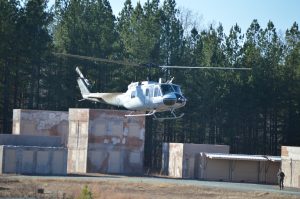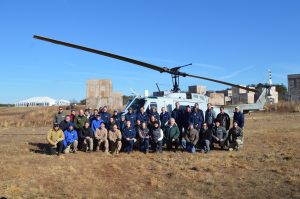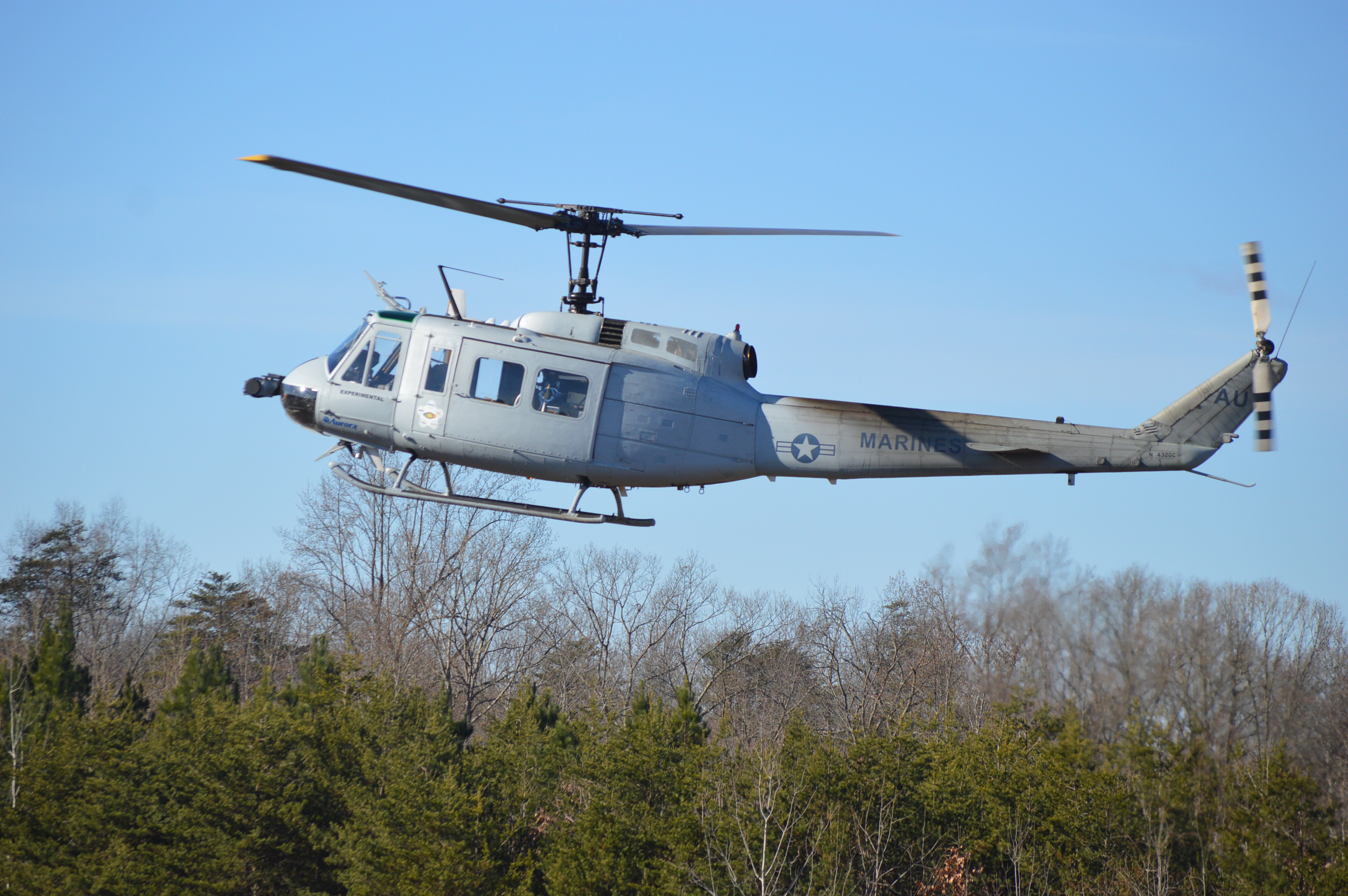Marines, Aurora demonstrate fully autonomous ‘Huey’
Autonomous flight: An AACUS-Enabled “Huey” negotiates a hazardous tree-line at Marine Corps Base Quantico, Virginia. (Anthony C. Hayes)
AACUS-Enabled Vietnam-era helicopter autonomously delivers payloads in rough terrain without a pilot at the controls.
MARINE CORPS BASE QUANTICO, VA: In the smart phone age, Americans have become used to tracking an Uber request or pizza delivery. Such luxuries don’t exist on the battlefield, where pizza deliveries are non-existent, and a call for a cab would land a soldier in the stockade. But what if a company of Marines needed ammunition or medical supplies in an area too “hot” to risk a manned resupply mission?
In the past, countless aviators have risked their lives to aid comrades in distress. Those days may be coming to a close, thanks to an ingenious autonomous helicopter system, developed under the Office of Naval Research (ONR) by Manassas-based Aurora Flight Sciences.

Named the Autonomous Aerial Cargo Utility System (AACUS), the program is an aircraft-agnostic hardware and software suite, which enables a Marine on the ground to request a supply delivery via helicopter, using a handheld tablet. Once loaded, the helicopter has the “brains” to negotiate even the most forbidding environment, while re-supplying Marines, without endangering a pilot and crew.
The United States Marine Corps (USMC) hosted a demonstration of AACUS yesterday at Marine Corps Base Quantico, Virginia. More than a hundred and fifty civilians braved a bitter wind to join an equal number of U.S. and international military observers – including Marine Corps Commandant General Robert B. Neller – as an AACUS-Enabled Bell UH-1H “Huey” conducted several low-level flights. The flights showcased the system’s ability to autonomously execute re-supply missions in relevant and austere settings.
“Autonomy is the future of where we’re going,” said Lt. Gen. Robert Walsh, Commanding General, Marine Corps Combat Development Command. “The young Marines of today have grown up in a tech-savvy, free-thinking society. This is our advantage. We’ve got to keep pushing and moving this (technology) forward.”
Though AACUS was developed under the ONR to meet the combat needs of the Marine Corps, Aurora is also working with the Army, which would likewise benefit from the advantages of autonomous aircraft.

The central control unit of the AACUS-Enabled UH-1H protrudes through the nose of the aircraft. Onboard sensors can detected both visible obstacles – such as buildings, trees, power wires and objects on the ground – and invisible hazzards – such as ground which is too soft for successful landing, or a landmine buried beneath the sand. Aurora representatives stressed that, unlike the remotely-piloted “joystick” controls of the first generations of drones, AACUS truly allows the aircraft to fly and land completely on its own.
“The Marines’ vision for the future of vertical lift operation and support is optionally-piloted aircraft,” said AACUS Program Manager Stephen Chisarik. “Aurora’s system enables any rotary-wing aircraft to detect and react to hazards in the flight path, and make appropriate adjustments to keep the aircraft safe.”
The demonstrations consisted of three carefully scripted missions to re-supply squads of Marines positioned in two mock villages. In every excursion (which covered several miles from base camp to mission objective), the “Huey” flew, landed safely, and then took off again, without a hitch.
In the co-pilot’s seat was Jason Jewell, Project Test Pilot. Jewell rode along (per FAA regulations) in case something with the autonomous test was amiss. Absent any problems, Jewell was present to observe the way the experimental system operated in flight and offer a test pilots perspective.
“What you saw here today was a modified Vietnam-era helicopter complete three missions on its own. The great thing about working on this program,” continued Jewell, “is it’s going to develop technology which is going to save lives someday.”

Jewell also mentioned the teamwork aspect of the system. A pilot (or trained technician) is needed to engage the system when the helicopter is on the ground. The process includes starting the computer for the day, coordinating each mission with supply personnel and the field operator, and throttling the rotor up to full RPM. Once the engine is up to speed, the base tecnician engages the system and lets the operator know the helicopter is ready to launch.
Jewell said he did not have to touch the flight controls until the “Huey” was on the ground – at which time he disengaged the system and prepared it for the next run.
Manning the operator’s tablet for one of yesterday’s test flights was Corporal Christopher Osterhaus.
“I’ve been lucky enough to grow up in the Marine Corps, where all of this new technology has been growing exponentially,” said Osterhaus. “The responsibility of the squad leader has been evolving over the last fifteen years. The fact that you could potentially give this tablet to a squad leader and have him controlling what his squad needs, when he needs it and where he needs it, is really exciting. It’s been a privilege to work on this project and see the future implications.”

Osterhaus said that mastering the tablet was one of the easier things he has learned in the Marine Corps.
“I’m confident that I could teach anyone how to operate this tablet in fifteen minutes. I’m also confident that, if an operator became incapacitated, someone could pick up the tablet and figure it out on the fly. That’s very big in the war-fighting community.”
Lt. Col. Dan Schmitt from the Marine Corps War Fighting Laboratory offered his perspective on the revolutionary system:
“I’m involved with a campaign we call Sea Dragon 2025. We look at how the world may look in 2025 and beyond, then develop concepts so that we can fight and win to achieve our national objectives.
“ACCUS is important because several things we see in the future are manned/unmanned teaming, artificial intelligence, machine learning and autonomy. Those are the things where we say, ‘We’d better get involved and do it, or it’s gonna be done to us.’ This is coming – the technology is there and it’s on the shelf. Our adversaries can get it. So, we’re gonna take this technology and insert it into our campaign. The end state is that we’re set up in 2025 to be asymmetrically dominant in the way we see the world at that point. We’re really taking the future and bringing it here now. That’s the ‘so what?’ of what you saw here today.”
Wednesday’s flights served as the final demonstration to ONR, Department of Defense representatives and other senior officials. Having completed the third and final phase of the program, AACUS will now transition to the Marine Corps for experimentation and potential acquisition.


Anthony C. Hayes is an actor, author, raconteur, rapscallion and bon vivant. A one-time newsboy for the Evening Sun and professional presence at the Washington Herald, Tony’s poetry, photography, humor, and prose have also been featured in Smile, Hon, You’re in Baltimore!, Destination Maryland, Magic Octopus Magazine, Los Angeles Post-Examiner, Voice of Baltimore, SmartCEO, Alvarez Fiction, and Tales of Blood and Roses. If you notice that his work has been purloined, please let him know. As the Good Book says, “Thou shalt not steal.”

